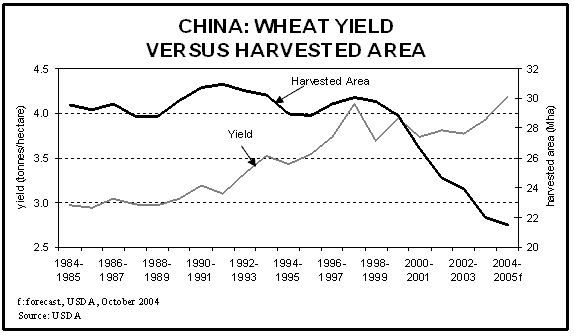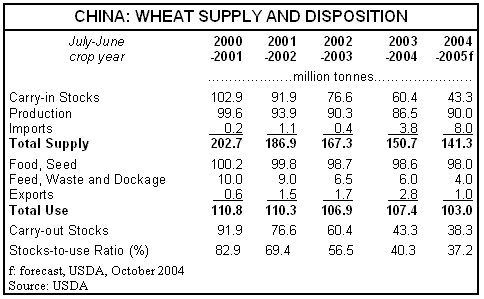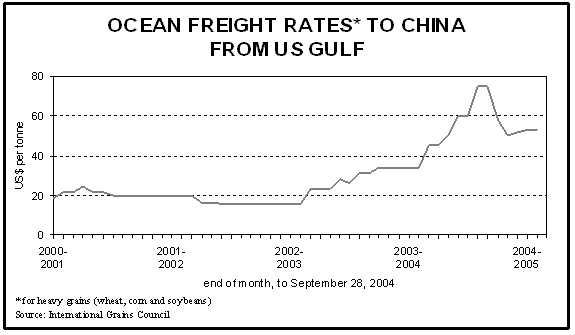Publications: Bi-weekly Bulletin
2004-10-29 | Volume 17 Number 16 | ISSN 1494-1805 | AAFC No. 2081/E
China: Wheat
In 2003-2004, China was the largest export market for Canadian wheat with an estimated value of $400 million. For 2004-2005, Canadian wheat exports to China are forecast at about 2 million tonnes (Mt), slightly higher than 2003-2004. China is expected to rely heavily on carry-over stocks and wheat imports to address the shortfall created by consumption exceeding domestic production. In view of the importance of trade and the tariff rate quotas for Chinese wheat imports, prompted by China's entry into the World Trade Organization (WTO), this issue of the Bi-weekly Bulletin examines the situation and outlook for Canadian wheat exports to China for 2004-2005 and over the medium-term.
Agricultural Policy For Wheat Has Become Less Protective
China has concentrated on reducing the area devoted to inefficiently produced crops and increasing area for high value, labour intensive crops in which China has some advantages. In several provinces, the price protection policy has been eliminated, but the policy still remains in the major wheat producing provinces. However, these protected prices have consistently been well below the domestic prices for wheat.
Chinese wheat stocks, which had reached a high of 103 Mt in 1999-2000, are estimated by the United States Department of Agriculture (USDA) to have fallen to their lowest levels in 25 years. With accession to the WTO in December of 2001, China has made commitments to open its markets to agricultural imports. In 2004-2005, China is expected to import more wheat than it has in 10 years.
The central purchasing agency, China National Cereals, Oils and Foodstuffs Import Export Corporation (COFCO), continues to play an important role in the importation of wheat, rice and edible oils. This government designated grain buying agent controls 90% of wheat imports into China. Private trading companies and mills apply for allocations for the remaining 10%.
Production has fallen due to lower harvested area
Over the last 5 years, Chinese winter and spring wheat areas have been approximately 90% and 10%, respectively, of the total wheat acreage. The main winter wheat producing area in China is the province of Henan, in the east-central area of the country, which accounts for about 33% of total wheat in both area and production. High quality wheat accounts for nearly 40% of Henan's total wheat acreage.
Chinese harvested wheat area has fallen each year since 1997-1998 and is currently forecast at 21.5 million hectares in 2004-2005, the lowest in modern times. For 2004-2005, Chinese wheat production is forecast at 90 Mt, up slightly from 2003-2004, largely due to expected record winter wheat yields.
Research Has Led To Higher Quality Varieties To Better Service Domestic Demand
High quality wheat production is expected to account for 30% of the 2004-2005 crop, compared to near zero production 5 years ago, due to government incentives to seed producers as well as increasing market demand.
Millers have reported that domestic production can now provide more wheat that meets milling properties, that was in the past mainly provided by imports. Higher protein and gluten content is the most noted improvement. Most millers have stated they must still import wheat to blend but the proportion of imports needed is less.
Consumption Patterns In Urban Areas Are Shifting To A More Balanced Diet
Wheat supplies have fallen by nearly 40% since 1999-2000 due to reduced seeded area, while Chinese imports have remained relatively low up until 2003-2004. Chinese per capita wheat consumption has in fact been shifting downward from a high of 85 kilograms (kg) in 1993 to 70 kg in 2003. In urban areas, however, per capita wheat consumption is estimated at 26 kg, by the Economic Research Service, USDA. Consumers have increasingly diversified their diets to include more vegetables, fruits, and meats, while consuming fewer grains. This shift in consumption patterns is most pronounced in the urban areas where consumers have higher incomes, better access to alternative foods, and have ownership of more refrigerators and freezers to store perishables.
For 2004-2005, Chinese domestic use is forecast at 102 Mt, down slightly from 2002-2003 and the lowest since 1990-1991.
Feed use has declined as wheat quality improved
Feed use has also fallen, from a high of 10.0 Mt in 2000-2001 to 6.0 Mt in 2003-2004. The outbreak of the avian influenza in late 2003 reduced demand for feed as poultry flocks were depopulated. As a result, 2004-2005 feed wheat use is forecast at 4.0 Mt, down one third from last year.
China is expected to continue to be a net importer of wheat
China was obligated to open a 9.636 Mt tariff rate quota (TRQ) for wheat in the 2004 calendar year, as a result of China's entry into the WTO in December of 2001. Under this agreement the wheat within this TRQ would have a 1% tariff, with imports beyond this quota carrying a duty of 65%.
In 2003-2004, the fill rate for the wheat TRQ was only 5%, according to USDA data. The effective value added tax on domestic wheat and imports is 13%. Nevertheless, low stocks of domestic wheat are expected to lead to a rise in imports for 2004-2005. For 2004-2005, wheat imports are forecast by USDA at 8 Mt, up from 3.8 Mt in 2003-2004, and the highest since 1995-1996.
Despite record ocean freight rates in 2003-2004, Canadian wheat exports to China increased from 154,000 tonnes (t) in 2002-03 to 1.7 Mt in 2003-2004. For 2004-2005, Canadian wheat exports to China are forecast at about 2.0 Mt, the highest since 1995-1996. Canadian wheat exports to China now consist largely of No.1 and No.2 Canada Western Red Spring with high protein levels. Over 50% of the wheat purchased in 2003-2004 was high quality compared to just 20%, 8 years ago. The other Canadian class of wheat exported to China is Canada Prairie Spring Red Wheat. In 2003-2004, the other major suppliers of wheat to China were the US at 1.4 Mt and Australia at 0.3 Mt.
According to the USDA, US wheat exports to China in 2003-2004 consisted of 0.6 Mt of Soft Red Winter (SRW), 0.6 Mt of hard red spring (HRS), and 0.2 Mt of soft white winter (SWW) wheat. As of October 6, 2004-2005 US wheat export sales commitments to China total 2.0 Mt, including 0.8 Mt of SRW, 0.8 Mt of HRS and 0.4 Mt of SWW wheat.
Chinese wheat exports are largely of feed quality, mainly to South Korea and the Philippines. Smaller amounts are sold to Vietnam, Hong Kong and Indonesia. Wheat is priced very low to compete with the large supplies in India and Ukraine. For 2004-2005, Chinese wheat exports are forecast at 1.0 Mt, down 63% from last year and below the 5-year average of 1.4 Mt.
Stocks are expected to continue to fall due to changes in domestic policy
Even though food consumption of wheat has been falling since the early 1990s, government policy encouraged production increases until 1999-2000. As a result, production surpassed consumption from 1996-1999. By the end of the 1999-2000 crop year, Chinese wheat carry-out stocks were estimated to be similar to annual consumption which imposed high costs on the government. To reduce these costs, the government eliminated protective prices and government procurement in many provinces and auctioned off older low quality domestic wheat stocks. These stocks were largely consumed domestically as feed in the livestock and poultry sectors.
With wheat production falling from 114 Mt in 1999-2000 to 86 Mt in 2003-2004, Chinese wheat supplies are forecast to fall from a record 212 Mt in 1999-2000 to 141 Mt in 2004-2005. Total domestic use is forecast to be well below the 10-year average at 102 Mt, however, it is expected to exceed production for the fifth consecutive year. As a result, carry-out stocks are forecast by the USDA to decrease to 38 Mt, down 12% from 2003-2004 and the lowest since 1983-1984. The stocks-to-use ratio is forecast at 37%, down from 40% in 2003-2004.
Flour exports to China are limited due to China's TRQ
For 2004-2005, Canadian exports of flour to China are forecast at 1,400 t, similar to last year. Chinese import tariffs for wheat flour are included in the wheat TRQ. However, the in-quota duty is 6% and the over-quota duty is 65%.
China is expected to continue importing wheat as it reduces its carry-out stocks
Chinese wheat purchasing delegations recently have visited several of the major wheat exporting countries. China has already committed to purchase about 5 Mt from Canada, the US and Australia in 2004-2005 which has supported world wheat prices. China's wheat supplies in recent years have been covered by drawing down its once large stocks of wheat. Although the size of the stocks is somewhat uncertain, these will eventually be depleted and will likely force the government to cover this shortfall with increased wheat imports. For 2004-2005, Chinese wheat imports are unlikely to exceed the current USDA forecast of 8.0 Mt.
According to the USDA Agricultural Baseline Projections, China's economic growth, which has consistently been the strongest in Asia, is expected to average about 7% over the next decade. The population growth rate is expected to slow to 0.6% in the next decade, compared to 1.5% from 1981-1990. However, China's urban population is expected to rise by 300 million people over the next 20 years.
China is expected to continue to be deficit in wheat. According to the US Food and Agricultural Policy Research Institute, Chinese wheat supplies are forecast to fall by 11% to 119 Mt through to 2013-2014. Wheat consumption is expected to remain relatively flat, rising marginally to 108 Mt in 2013-2014. As a result, Chinese wheat stocks are forecast to continue to fall to 21.5 Mt in 2013-2014. With this expected fall in wheat stocks, Chinese wheat imports are forecast to continue to increase.
The Canadian Wheat Board has forecast total Chinese wheat imports to rise to 5-10 Mt annually over the next decade, with demand strongest for high quality, high protein wheat. Canada is expected to be well positioned to continue to service China's expanding import market for wheat.
Zhengzhou Commodity Exchange (CZCE): New Wheat Futures Contract
The CZCE announced on March 4, 2003 that it would start trading in high quality wheat futures on March 28, 2004. The contracts months are January, March, May, July, September and November. Contracts are denominated in yuan/short ton (y/st) and each contract is 10 y/st, with a 3% limit to daily movements. The Exchange already deals in futures for lower-quality wheat. Zhengzhou is in the Province of Henan.
by
While the Market Analysis Division assumes responsibility for all information contained in this bulletin, we wish to gratefully acknowledge input from the following: Canadian Wheat Board, Market and Industry Services Branch (AAFC)
|
|
||
| Date Modified: 2006-12-08 |
|
|
|
[ Français | Contact Us | Help | Search | Canada Site ] [ AAFC Online | Links | Newsroom | What's New | Site Index ] |
||







